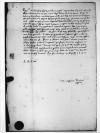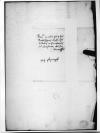received [1537]-08-11
Manuscript sources: | 1 | fair copy in Latin, autograph, BCz, 2713, p. 7-8
| | 2 | copy in Latin, 18th-century, BK, 222, No. 64, p. 212
| | 3 | copy in Latin, 19th-century, AAWO, AK, Dok. Varia 42
| | 4 | copy in Latin, 18th-century, BCz, 55 (TN), No. 36, p. 197-198
| | 5 | register with excerpt in Latin, English, 20th-century, CBKUL, R.III, 32, No. 592
|
Auxiliary sources: | 1 | register in Polish, 20th-century, B. PAU-PAN, 8248 (TK 10), f. 538
|
Prints: | 1 | NIEMCEWICZ 4 p. 65-66 (Polish translation) | | 2 | COPERNICUS 1854 p. 585 (in extenso; Polish translation) | | 3 | Kopernikijana No. 8, p. 80 (Polish translation) | | 4 | Spicilegium No. 11, p. 199-200 (in extenso) | | 5 | Autografi Tav. IV (facsimile) | | 6 | PROWE 1884 p. 159-160 (in extenso) | | 7 | DE VOCHT 1961 No. DE, 361, p. 296 (in extenso) | | 8 | SIKORSKI 1968 No. 391, p. 99 (Polish register) | | 9 | Kopernik na Warmii No. 413, p. 491 (Polish register) | | 10 | RC No. 369, p. 164 (English register) | | 11 | DREWNOWSKI 1978 No. 6, p. 231-232 (in extenso; Polish translation) | | 12 | COPERNICUS 1992 Rękopisy No. VIII.13-14, p. 15 (facsimile) | | 13 | NCG 6/1 No. 108, p. 213-215 (in extenso; German translation) | | 14 | KOESTLER 2002 p. 176 (reference) | | 15 | COPERNICUS 2007 p. 186-187 (in extenso) | | 16 | COPERNICUS 2007 p. 197-198 (Polish translation) | | 17 | WASIUTYŃSKI 2007 p. 383 (Polish translation) |
|

